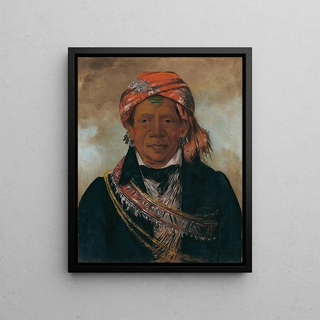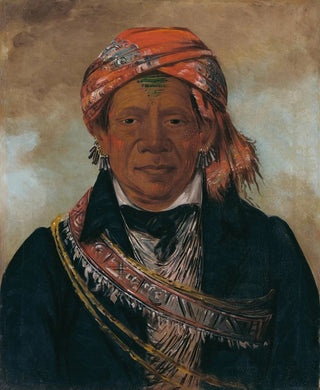Painting BdA-Sin Chef de la tribu - George Catlin | Art print Source: Tableau BdA-Sin Chef de la tribu - George Catlin | Reproduction


View from behind

Frame (optional)
The artwork "BdA-Sin Chief of the Tribe" by George Catlin is much more than a simple artistic representation. It embodies a precious moment in the history of Indigenous peoples of America, capturing the essence of a rich and complex culture. Catlin, as a traveling artist, was able to immortalize with great sensitivity the faces and stories of the tribes he encountered. This art print, faithful to the original, allows us to grasp not only the image of a chief but also the soul of a time when the meeting of cultures was both fascinating and tragic. Through this piece, the viewer is invited to delve into a world where respect for traditions and the quest for identity intertwine, offering a reflection on man's place in nature.
Style and uniqueness of the work
George Catlin's style is characterized by a naturalist approach, but also by a romantic sensitivity that sets him apart from his contemporaries. In "BdA-Sin Chief of the Tribe," there is a meticulous attention to detail, whether in the features of the chief's face or in the clothing elements that evoke his status and role within the tribe. The vibrant colors and balanced composition of the work help create an atmosphere that is both solemn and intimate. Catlin does not merely reproduce an image; he tells a story, that of a people and their struggles, while preserving the individuality of his subjects. This uniqueness makes each piece a living testimony, an open window to a often little-known past.
The artist and his influence
George Catlin, born in 1796, is often considered one of the first artists to dedicate his career to the representation of Indigenous peoples of North America. His commitment to preserving their traditions and way of life was motivated by a deep admiration for these cultures threatened by European expansion. Through his travels and portraits, Catlin not only documented the diversity of tribes but also helped raise awareness of issues related to colonization. His influence endures today, inspiring many artists

Matte finish

View from behind

Frame (optional)
The artwork "BdA-Sin Chief of the Tribe" by George Catlin is much more than a simple artistic representation. It embodies a precious moment in the history of Indigenous peoples of America, capturing the essence of a rich and complex culture. Catlin, as a traveling artist, was able to immortalize with great sensitivity the faces and stories of the tribes he encountered. This art print, faithful to the original, allows us to grasp not only the image of a chief but also the soul of a time when the meeting of cultures was both fascinating and tragic. Through this piece, the viewer is invited to delve into a world where respect for traditions and the quest for identity intertwine, offering a reflection on man's place in nature.
Style and uniqueness of the work
George Catlin's style is characterized by a naturalist approach, but also by a romantic sensitivity that sets him apart from his contemporaries. In "BdA-Sin Chief of the Tribe," there is a meticulous attention to detail, whether in the features of the chief's face or in the clothing elements that evoke his status and role within the tribe. The vibrant colors and balanced composition of the work help create an atmosphere that is both solemn and intimate. Catlin does not merely reproduce an image; he tells a story, that of a people and their struggles, while preserving the individuality of his subjects. This uniqueness makes each piece a living testimony, an open window to a often little-known past.
The artist and his influence
George Catlin, born in 1796, is often considered one of the first artists to dedicate his career to the representation of Indigenous peoples of North America. His commitment to preserving their traditions and way of life was motivated by a deep admiration for these cultures threatened by European expansion. Through his travels and portraits, Catlin not only documented the diversity of tribes but also helped raise awareness of issues related to colonization. His influence endures today, inspiring many artists
12,34 €






